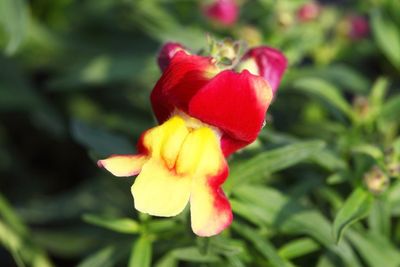Hybridizing Snapdragons Plants
For centuries, plant breeders have created new hybrids from cross pollination. Through this technique they are able to change a plant’s characteristics, such as bloom color, bloom size, bloom shape, plant size, and plant foliage. Due to these efforts, we now have many flowering plants that produce much wider varieties of bloom color. With a little knowledge of flower anatomy, a pair of tweezers, a camel hairbrush, and clear plastic bags, any home gardener can try their hand at hybridizing snapdragon plants or other flowers. Plants reproduce in two ways: asexually or sexually. Examples of asexual reproduction are runners, divisions, and cuttings. Asexual reproduction produces exact clones of the parent plant. Sexual reproduction occurs from pollination, in which pollen from the male parts of plants fertilizes female plant parts, thus causing a seed or seeds to form. Monoecious flowers have both male and female parts within the flower, so they are self-fertile. Dioecious flowers have either the male parts (stamens, pollen) or the female parts (stigma, style, ovary) so they must be cross pollinated by wind, bees, butterflies, hummingbirds, or gardeners.
Cross Pollinating Snapdragons
In nature, snapdragons can only be cross pollinated by large bumblebees which have the strength to squeeze between snapdragon’s two protective lips. Many varieties of snapdragon are monoecious, meaning their flowers contain both male and female parts. This does not mean that they can’t be cross pollinated. In nature, bees often cross pollinate snapdragons, causing unique new flower colors to form in garden beds. However, in order to manually create hybrid snapdragon seeds, you will need to select newly formed flowers to be the parent plants. It’s important to select flowers that have not already been visited by bees. Some of the selected snapdragon parent plants will need to be made purely female. This is done by opening the lip of the flower. Inside, you will see a central tube-like structure which is the stigma and style, the female parts. Next to this will be the smaller long, thin stamens, which need to be gently removed with tweezers to make the flower female. Plant breeders will oftentimes mark male and female varieties with different color ribbon to avoid confusion. After the stamens are removed, use a camel hairbrush to collect the pollen from the flower you have chosen to be the male parent plant and then gently brush this pollen onto the stigma of the female plants. To protect the flower from further natural cross pollination, many breeders then wrap a plastic baggie over the flower they manually pollinated. Once the flower goes to seed, this plastic bag will catch the hybrid snapdragon seeds that you have created so that you may plant them to discover the outcome of your creations.
